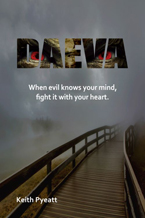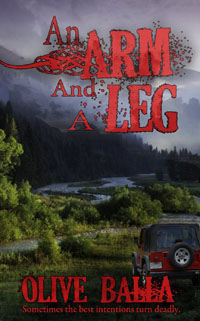by Keith Pyeatt
 Suspense is an emotion. It’s that feeling when you don’t know what’s going to happen next…but you want to. Using that definition, it’s easy to see why creating suspense is an effective way to keep readers turning pages.
Suspense is an emotion. It’s that feeling when you don’t know what’s going to happen next…but you want to. Using that definition, it’s easy to see why creating suspense is an effective way to keep readers turning pages.
I write in the broad category of suspense/thriller, and I was already scheduled to write this article when the print galleys for my novel Dark Knowledge arrived. While I searched for typos, I also noted the different ways I generated suspense so I could share some of my favorite methods with you.
1. Use setting to enhance or create suspense. I mention setting first because I used it to build suspense right from the opening paragraphs of Dark Knowledge. My mentally challenged protagonist, Wesley, enters a world inside his mind that’s shrouded in fog, radiates a “bad color” that terrifies him, and proves it can hurt him. The mind-world became a steady source of suspense because I kept it mysterious, dangerous, and full of paranormal surprises, but suspenseful settings certainly don’t need to be supernatural ones. A boat on rough seas, a job interview, or a packed department store during a bridal sale can all add tension and suspense, especially if there’s a pregnant passenger on the boat, the interviewee needs the job to feed his family, and there’s a good reason why the bride-to-be needs a certain gown.
2. Withholding information from readers can generate suspense, but be careful not to be too obvious and cheesy about it (like I was with the title of this article) or the reader will feel manipulated. Withheld information works best when it’s natural. For example, the point of view (POV) characters introduced so far don’t know the information, so they can’t relay it to the reader. This method is a clear favorite of mine, and it works well because I normally have multiple POV characters in my novels, which helps me control when information is presented.
3. Withholding information from the protagonist is another great way to create suspense, especially in novels with multiple POV characters. Let that antagonist reveal his dastardly plans to the readers. Doing so creates the classic “Don’t go in there!” response when readers know the bad guy is waiting behind the door with a knife but the hero doesn’t. Note that this type of suspense pretty much defines the difference between suspense and mystery novels. In a mystery, we know Professor Plum was killed from the beginning pages, but we don’t know who bludgeoned him to death with a candlestick until the end. The fun is trying to figure out who did it and why. In a suspense/thriller, the professor is alive, but the readers know Miss Scarlet’s plans and motivations to kill him. The suspense is whether the hero will discover the plan and be able to stop Professor Plum from meeting his death in the library.
4. Impose a time restraint. Whether the bank will repossess Grandma’s iron lung if money isn’t raised in time or the wormhole that leads to present day Earth is about to close, a hero’s race against a ticking clock adds urgency and suspense.
5. Complicate things. For an added shot of suspense, start the ticking clock mentioned above, and just when it looks like your hero might actually succeed in time, drop a delay or complication on her. Now will she make it? Yes? Drop another complication on her.
6. Be unpredictable. Readers are smart, and once they get used to the flow of a story, they may start thinking they know where it’s going. Add an unexpected twist, and now they’re in suspense about how this new development, revelation, or character will change the course. The only way to know is to keep reading.
7. Mind games are another of my favorite ploys, which is probably why my paranormal thrillers can also be classified as psychological thrillers. I love a good dilemma, and there’s a whopper of one in Dark Knowledge that stands out as a suspenseful element. Wesley doesn’t know whether to sacrifice his life to save his soul or if he needs to sacrifice his soul to protect mankind from evil. With a big dilemma like that, readers get a whole new element of suspense. In addition to wondering “can he succeed?” and “can he succeed in time?” they wonder along with the character which course of action leads to success. Smaller dilemmas add suspense too, so experiment with them. Create a reason your protagonist can’t, won’t, or shouldn’t do something, then make sure he must do it to get what he needs. Or give him options, but make sure every option has a serious downside.
8. Create a convergence where separate lines of action meet, combine their energies, and shoot the story forward. In Dark Knowledge, there’s a point where three scenes, each written from a different character’s POV, bring story-lines together as the characters charge into the mind-world for the climactic battle. Different motivations drive each character to the same point, and the convergence supercharges the tension and suspense.
9. Make the hero act alone or at a disadvantage. There’s strength in numbers, so isolate your character when he needs help the most. Wesley has friends who would do anything for him, so I…Well, I’m not telling, but isolating the main character is a technique I frequently use to beef up suspense. A variation of isolation is to impose a disadvantage on your hero at a critical time. Maybe your urban fantasy heroine left her sword on all night and discovers it’s out of juice just as a shape-shifting monkey demon attacks. Now how’s she going to fight it?
10. Make the reader care about the characters. Sure, determined government hit men in helicopters chasing a desperate man through an active minefield is high action and may grab a reader’s attention, but the suspense you need to hold interest comes from giving the readers reasons to care what happens to the desperate man. Let readers into your hero’s head. Better yet, into his heart. Flesh out your antagonists and other major characters so readers care what happens to them, too.
Remember, suspense is an emotion.
 Keith Pyeatt served as an officer of SouthWest Writers for three years and received the SWW Parris Award in 2009. He writes paranormal thrillers that he calls “Horror with Heart.” He now lives in Tucson, Arizona, and he recently released his fourth novel, Daeva. Other published novels are Struck, Dark Knowledge, and Above Haldis Notch. Find out more about Keith by visiting his website at KeithPyeatt.com or his blog at Keithpyeatt.blogspot.com.
Keith Pyeatt served as an officer of SouthWest Writers for three years and received the SWW Parris Award in 2009. He writes paranormal thrillers that he calls “Horror with Heart.” He now lives in Tucson, Arizona, and he recently released his fourth novel, Daeva. Other published novels are Struck, Dark Knowledge, and Above Haldis Notch. Find out more about Keith by visiting his website at KeithPyeatt.com or his blog at Keithpyeatt.blogspot.com.
This article was originally published in the November 2012 issue of SouthWest Sage and is reprinted here by permission of the author.



